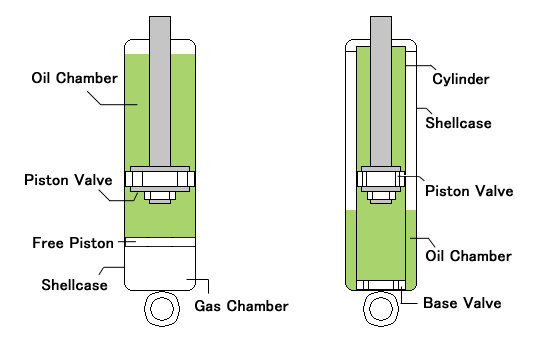This is something I wrote for another forum where they were going back and forth between twin tube and mono tube dampers, but I thought it applied here. . . just a long winded, basic introduction to shock absorber design.
Shock design and function is something that will be argued for as long as we own these cars.
Just so you all know where I'm coming from. . . I grew up dirt track racing, using everything from OE shocks, to PRO shocks, to Integra shocks, to Bilstein shocks, to Ohlins.
This is a “nuts and bolts” explanation of dampers. You all decide which is best. . .it’s your money.
Back in the day we (Ridetech) were using Brand "X" shocks and were having issues keeping the shocks together. Though we own a 5HP Roehrig shock dyno, I rented the EMA dyno at Roehrig Enders in Morrsville, NC and spent a few days blowing up shocks to figure out what was going on. We needed the EMA (electromagnetic actuation technology) as our 5HP could only go up and down 2". The EMA allowed us the ability to stroke the shock at any measurement we wanted, and at any speed. . .so I could take a data acquisition file from a street car and “play it back” on the dyno. . .the shock would travel 1/8” in up and down in 0.1 second or less (mimicking going over very small bumps in the road). I could also run square waves, triangle waves, etc (however, that’s for another thread).
What we found was that the twin tube shocks we were using were not allowing the fluid to return to the main chamber quickly enough. This built-up hydraulic fluid would pressurize the shock cap and blow it off with a crap ton of force.
Now, I’m not saying every twin tube is a poor design. . .just that the one I had under test was. We’ve switched back and forth on the dirt cars between twin tube and mono tube a lot!
However, everything I’ve seen in a street car indicates a monotube is much more efficient.
Now, let’s think about shocks. . .their main purpose is to convert kinetic energy into heat. I.E. . . dissipating the suspension movement into heat in the dampers. If the shock valving is equal, it comes down to which design can convert the most amount of movement to heat. However, we must also consider the time variable. If one damper can dissipate a lot of heat, but it becomes “heat soaked”, its efficiency drops dramatically in a short period of time. If another damper can dissipate a lot of heat, and not become “heat soaked” nearly as soon, its efficiency drops much later.
Heat is created in a damper in two ways. . .
1-fluid movement through the piston and valve stack
2-movement of fluid around the damper
Let’s look at the basic design of each version. . .

On the left is the gas charged monotube. . .on the right is the twin tube. I should take a moment and explain most decent twin tubes are also gas charged. Some have a small plastic bag filled with nitrogen that is inserted around the inner tube, some have an actual gas chamber.
Monotube: As you can see there is only one tube. Said tube contains two media, oil and nitrogen gas. These are separated by a dividing piston which can “float” up and down the tube.
As the oil in the monotube is typically held under high pressure (75-300psi) you should think of the oil as a solid column. As the shock moves the oil is not pushed through the piston, the piston is pushed through the oil. The oil, for the most part, stays in the same place.
As the shaft is compressed into the body the volume the shaft displaces must be offset, otherwise the shock would blow up. So to accomplish this the dividing piston floats down the tube, further compressing the gas below it.
Twintube: As you can see there are two tubes, and inner tube in which the piston rides, and an outer tube which is used as a chamber to store excess oil.
As the shaft is compressed in a twintube the shaft volume must also be displaced. The oil is forced through the base valve and into the outer chamber. In the twintube the oil physically turned 180 degrees and passed through a valve. This creates more heat.
Now let’s look at the actual pistons being used. The piston and shim stack of the damper is what is creating the actual shock force, regardless of shock design (though both versions have other valves/ports/orifices that influence the overall shock force).
Here’s an image I pilfered from the Bilstein site that illustrates the size difference between the two pistons:

As you can see the monotube piston is MUCH larger, and therefore theoretically more efficient.
Damping Adjustment:
You will notice Ridetech offers single adjustable (HQ) or triple adjustable (TQ) dampers.
Why only one adjuster? Wouldn’t it be better to have two?
First let’s discuss how a shock handles vehicle tire and body movement.
The job of a shock absorber, when on the track, is that of a timing device. . .nothing more. Its sole purpose is to make sure the vehicle is in the correct orientation for what it’s doing. I.E., if the car is under braking the front shocks need to slow the compression forces just enough that the front tires are loaded, but not so much that the front “smacks” the bumpstop and unloads the tires. The rear shocks are providing just enough rebound force to allow weight transfer to the front while keeping the rear tires on the ground (if they provide too much rebound the rear tires will be physically lifted off the ground and you get the “loose in” wiggles.)
Now, the car has slowed enough that turn in could be made. As the vehicle is turned the force is now trying to compress the outside suspension further. The shocks job is basically the same as listed above, but now the inside shocks are providing rebound force.
After the turn is mostly made, you reach apex. What orientation should the car be in now? As neutral as it can be. Apex is the point at which the force of braking and turning are over and the force of accelerating is about to take place. So you want the car back to neutral. It’s the shocks job to make sure this timing is correct. If the front shocks have too much rebound and the front is still down at apex you’ll have a “loose off” condition. If the front shocks have too little rebound and the front is now in the air at apex you’ll have a “push off” condition.
Though it may seem you need the ability to adjust both compression and rebound this is really only true for the true “track guys”. Most of us mere mortals will only go to a track or high performance driving event 3-5 times a year. That means the vehicle spends 90+% of its time on the street.
When the suspension is compressed the spring is compressed and the shock is providing compression force (resistance to being compressed). So the compression side has the spring to help it slow down the suspension.
When the suspension is extended the spring becomes the enemy of the damper. Not only do you have the physical weight of the suspension being pulled away from the vehicle, but you also have a spring pushing it away. As such you need a lot more rebound force than you do compression force.
Remember, rebound is king!
It is my theory that in a “mostly street with some HPDE stuff” shock you run as little compression valving as you can and a crap ton of digressive rebound. This provides a nice comfortable ride on the street (the compression force of the shock is not inducing extra spring rate) and the rebound, when adjusted toward the stiff side, is plenty to get the timing right at the track. Though it’s not the best overall, it is the best of both worlds with the smallest trade off (trade off being the possibility of not having enough compression at the track. Though this is unlikely and can often be mitigated with spring rubbers).
The monotobe design lends itself to a single rebound adjuster, unless you have a remove reservoir in which case it can then more easily utilize a compression adjuster.
However, remote resis and parts add cost, so most people won’t go that far.
I hope this has been a relatively unbiased explanation of dampers and that you all got something out of it.
I feel once you have a basic understanding of how shocks work you’ll be able to ask the right questions regarding your intended purpose for your car.
This is a basic description of shocks with a bit of a high performance driving slant. If you'd like a more "street" description I can do that as well. Just let me know.




